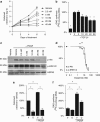The tyrosine kinase inhibitor dasatinib (SPRYCEL) inhibits chondrocyte activity and proliferation
- PMID: 22829108
- PMCID: PMC3255273
- DOI: 10.1038/bcj.2011.1
The tyrosine kinase inhibitor dasatinib (SPRYCEL) inhibits chondrocyte activity and proliferation
Figures


Similar articles
-
Dasatinib: a tyrosine kinase inhibitor for the treatment of chronic myelogenous leukemia and philadelphia chromosome-positive acute lymphoblastic leukemia.Clin Ther. 2007 Nov;29(11):2289-308. doi: 10.1016/j.clinthera.2007.11.005. Clin Ther. 2007. PMID: 18158072 Review.
-
Efficacy and Safety of Generic Dasatinib as a Second-line Treatment for Patients with Chronic Myeloid Leukemia: a Multicenter Retrospective Study in Hubei Province, China.Curr Med Sci. 2018 Dec;38(6):1005-1011. doi: 10.1007/s11596-018-1976-0. Epub 2018 Dec 7. Curr Med Sci. 2018. PMID: 30536062
-
Mechanisms of the Cardiac Myocyte-Damaging Effects of Dasatinib.Cardiovasc Toxicol. 2020 Aug;20(4):380-389. doi: 10.1007/s12012-020-09565-7. Cardiovasc Toxicol. 2020. PMID: 32124237
-
Hair depigmentation during chemotherapy with dasatinib, a dual Bcr-Abl/Src family tyrosine kinase inhibitor.J Drugs Dermatol. 2009 Apr;8(4):395-8. J Drugs Dermatol. 2009. PMID: 19363859
-
Dasatinib: A Review in Pediatric Chronic Myeloid Leukemia.Paediatr Drugs. 2018 Dec;20(6):593-600. doi: 10.1007/s40272-018-0319-8. Paediatr Drugs. 2018. PMID: 30465234 Review.
Cited by
-
The impact of dasatinib on pregnancy outcomes.Am J Hematol. 2015 Dec;90(12):1111-5. doi: 10.1002/ajh.24186. Epub 2015 Oct 12. Am J Hematol. 2015. PMID: 26348106 Free PMC article.
-
A combination of tyrosine kinase inhibitors, crizotinib and dasatinib for the treatment of glioblastoma multiforme.Oncotarget. 2015 Nov 10;6(35):37948-64. doi: 10.18632/oncotarget.5698. Oncotarget. 2015. PMID: 26517812 Free PMC article.
-
Development of a cell-based pathway modulator screening system to screen the targeted cancer therapeutic candidates.Hum Cell. 2021 Mar;34(2):445-456. doi: 10.1007/s13577-020-00476-x. Epub 2021 Jan 6. Hum Cell. 2021. PMID: 33405176
References
-
- Lombardo LJ, Lee FY, Chen P, Norris D, Barrish JC, Behnia K, et al. Discovery of N-(2-chloro-6-methyl-phenyl)-2-(6-(4-(2-hydroxyethyl)-piperazin-1-yl)-2-methylpyrimidin-4- ylamino)thiazole-5-carboxamide (BMS-354825), a dual Src/Abl kinase inhibitor with potent antitumor activity in preclinical assays. J Med Chem. 2004;47:6658–6661. - PubMed
-
- Vandyke K, Dewar AL, Farrugia AN, Fitter S, Bik To L, Hughes TP, et al. Therapeutic concentrations of dasatinib inhibit in vitro osteoclastogenesis. Leukemia. 2009;23:994–997. - PubMed
-
- Kantarjian H, Shah NP, Hochhaus A, Cortes J, Shah S, Ayala M, et al. Dasatinib versus imatinib in newly diagnosed chronic-phase chronic myeloid leukemia. N Engl J Med. 2010;362:2260–2270. - PubMed
-
- Mariani S, Giona F, Basciani S, Brama M, Gnessi L. Low bone density and decreased inhibin-B/FSH ratio in a boy treated with imatinib during puberty. Lancet. 2008;372:111–112. - PubMed
LinkOut - more resources
Full Text Sources
Other Literature Sources

